The Flavor of Memory: Lamb And Rice Filled Grape Leaves
On Sunday, I had a powerful desire for rice and lamb stuffed grape leaves–dolmathes, (or dolmades) as they say in Greek, or dolma in Turkish. Actually, dolma is just a general name for stuffed leaves, fruits or vegetables, stuffed grape leaves are more properly called yaprak dolma. And I wanted them home-made, none of those canned ones which are very commonly found in Greek and Middle Eastern grocery stores and restaurants.
Mind you, quite a few brands of the canned dolmathes are not -bad-, but they still cannot hold a candle to the real, honest to God real homemade thing. I wanted excellent dolmathes, stuffed with rice and lamb, like the ones I used to eat either at my Aunt Nancy’s house or at the Greek restaurant in Charleston. (I ate at Best of Crete in Charleston a lot when I was pregnant with Morganna–and the wonderful woman who ran the restaurant with her tall, well-grown adult sons used to slip me extra treats because I was pregnant. And she would never, ever let me drink anything but milk. I could order tea and get milk anyway. At the cheaper tea price, mind you, but she was adamant that I drink the milk so my baby would have strong bones. Morganna has never broken a bone, mind you…though she has tried.)
To me, good dolmathes take me back to happy times in my earlier life. The smell of them simmering on the stovetop make me think of the smells coming out of Mrs. Zakaib’s open kitchen door that drifted across her backyard and down the alley where the neighborhood kids played. She was an interesting lady–most of the kids were scared of her rather stern demeanor, but she was truly nice. She just didn’t put up with nonsense. She also used to harvest leaves from our next-door neighbor’s Concorde grape vines in their backyard–with their permission of course. The vines had been there when they moved in, so they didn’t care if she picked them. I used to help her by climbing up the arbor to get the ones she couldn’t reach because she was so little.
She’d give me honey cookies for my trouble, and I was one of the kids in the neighborhood that she was always nice to, in large part because I was helpful and polite.
While I picked the leaves, she told me all about how to prepare them to use for dolma.
But, it wasn’t Mrs. Zakaib who taught me how to make dolmathes.
It was my Aunt Nancy.
She’s the one who taught me how to roll them up and how to cook them.
She never had fresh leaves to work with; she always used the tightly packed jars of grape leaves in brine that you could get at Greek and Middle Eastern grocery stores, even in Charleston, West Virginia back in the seventies and eighties. She’d buy a big jar of the leaves, and then carefully pull the tightly stacked, wrapped and rolled leaves out of their glass home, draining the brine as she did so. This took patience and not a little effort–those leaves are really, really tight in the jar and it is hard to get them out without tearing them. But she showed me how to use a rubber spatula or table knife to ease down the jar between the glass and the leaves to sort of break the seal from the vacuum packing, and get a little air in there to help slip the leaves out in a single bundle. She would turn the jar upside down after that, and drain the brine, and then with her finger and thumb, get a good hold on the leaf bunch and begin tugging it gently down while shaking the jar downward with the other hand.
Eventually, after a bit of work, the leaves would ease down into her hand with a whispered “pop,” and invariably the last bit of brine would drizzle down the arm holding the leaves. (That’s why you always wear short sleeves when you make grape leaf rolls,” she said to me once, with a grin. “Arms wash easier than shirts.”
Once out of the jar, the leaves are laid into a deep, wide bowl and then covered with boiling water. This leaches out excess salt and it also helps to loosen the leaves which have been stuck together in the jar so tightly that they really don’t want to do anything but cleave to each other.
But no matter what the leaves think about it, they need to come apart, so they get a boiling water bath.
Once the water is cool enough for your hand to go in, the leaves have usually let go of each other and you can swish them around a bit to loosen them up further. Then, you drain them in a colander and put them back in the bowl, and cover them with cold water and swish around, then drain and then repeat the cold water, swishing and draining dance once again. This removes the excessive salty flavor that the brine imparts, allowing the natural lightly bitter green flavor of the leaves to present itself to the front of the palate.
While the leaves are soaking in the boiling water is when you want to make your stuffing.
Lots of recipes call for cooked meat and rice to be used in the stuffing, but Aunt Nancy said that she didn’t think that those kinds of grape leaf rolls had as much flavor as the ones like she made where the meat and rice are uncooked when they go into the leaves, and then are cooked. When you do it that way, the unique flavor of the leaves permeates the meat and rice, making them fragrant and amazingly delicious. You also end up with more moist rolls that way.
(Now, I did not know this at the time when I was learning to make these dolmathes from Aunt Nancy, but you don’t need to have any meat in the stuffing–you can use rice and lentils instead or rice and pine nuts with currants or golden raisins. In the case of vegetarian stuffings, you use cooked lentils and rice–otherwise the stuffing mixture would not hold together and stuff the leaves very well–it would all fall apart and leak out and make a royal mess in your cooking pot or pan.)
Aunt Nancy used good ground beef and long-grain rice in her stuffing; I prefer ground lamb and basmati rice. Aunt Nancy liked lamb better too, but it was hard to find in West Virginia back then. She seasoned her filling with finely grated onion, a little bit of minced garlic, some tomato paste and some chopped parsley.
I used more seasoning in my stuffing and added pine nuts, but no matter what you use for the stuffing, you roll the leaves up into little packets the same exact way.
First, you cut the stems off of the leaves and discard them.
Then, you lay the leaf out on a clean work surface with the bottom edge facing your body, and the top jaggedy edges pointing away from you. Before you lay the leaf down, however, notice that the leaf has two sides, the shiny, darker green side and the kind of bumpy, dull-colored and paler green side. You lay the leaf shining side down so that the prettier side will be on the outside of the leaf when you are done. Also, because of the way the veins on the leaves are structured, the leaf will roll up more easily with the bumpy side to the inside and the smooth side to the outside.
Then you take between a teaspoon and a heaping tablespoon of filling mixture (in the Middle Eastern countries, dolma are made thinner than they are ever made in the US. In the photographs I have seen of dolmas from Arab countries, they are no thicker than a woman’s finger, whereas the ones Aunt Nancy made and I later ate in Greek restaurants here in the US, are always thick and somewhat pudgy-seeming. About the thickness of a not small woman’s thumb.
So the amount of filling you pick up depends on how thin or fat your want your dolmathes to be. I like mine fat, so I grabbed up heaping tablespoonsful of the meat and rice mixture and shaping it in one hand, worked it into a roughly cylindrical shape. Or, if you want, a football shape.
This filling is placed down on the bottom of the leaf, about 1/2″ from the bottom edge.
Then you carefully curl the bottom edge of the leaf over the filling and start to roll it up. Give it one and a half rolls, just to tuck the filling “into bed” as Aunt Nancy used to say, then you start folding the sides of the leaf into the center, like you were making a little verdant envelope.
When you fold in the edges, bring them tightly against the filling, and sort of crease the top edge of the leaves where they are folded tightly. You will end up with what looks like a little packet, with an open bit at the top that looks all pointed from being the central, pointy top edge of the leaf.
Then, keeping the leaf as tightly tucked as possible, you continue rolling upwards until you have a nicely filled and tucked and rolled up dolmathe. When you set the grape leaf roll down, you will be setting it seam side down so it doesn’t get all uppity in the pot and start unraveling itself as it is simmering. That would just not look good, nor would it taste very good, because you want to taste the leaf and the filling all at once. Otherwise, it is just like eating meatballs cooked with leaves, and if we wanted that, we’d have made meatballs with leaves in the first place and saved ourselves the trouble of all that rolling, tucking and rolling again.
Now let’s talk about the pot you are going to cook your dolmathes in.
First of all, you have to decide if you are going to cook these on the stove, or if you are going to cook them in the oven. Aunt Nancy did hers on the stove, but in culinary school, we did them in the oven, so I know for a fact both ways work equally well. It all depends on how you want to do it. If your oven sucks, then use the stovetop method. If you are afraid you will forget to watch the stove to keep the pot from running out of cooking liquid and burning the grape leaves, well, then by all means cook it in the oven. That is only being sensible!
It doesn’t matter if you simmer on the stove or bake the dolmathes, you prepare the pot or pan the same way.
You put a layer of grape leaves–you can use the ones that inevitably get torn in the fight to get them out of the jar–on the bottom of your chosen cooking vessel. This prevents the rolls from burning and sticking to the bottom.
Then, I like to put slices of lemon and onion, and sometimes, slices of fresh garlic cloves in a layer over the leaves. These not only elevate the rolls further, but they also add extra flavor to the cooking liquid, which means it adds extra flavor to the dolmathes themselves, which take on the flavors and aromas of whatever they are cooked with.
It is over these layered leaves and aromatics that you layer your dolmathes, placing them carefully seam side down, in concentric rings around the pot, starting along the outside and working inward.
When a layer is completed, repeat the layering process–cover the dolmathes with a flat layer of grape leaves, then the aromatics of your choice and then the second layer of dolmathes. This can theoretically can go on forever, until you run out of grape leaves, dolmathes or room in your cooking vessel of choice. Stop with a layer of dolmathes, though, so you can add your cooking liquid.
Now, the cooking liquid.
Some people use just water, but I think that is a waste of an opportunity to add more flavor to the dolmathes which take on the flavors of whatever they are cooked in and with.
Others use a can of tomatoes, but I am not one of them. I use tomato paste in my meat filling, so I see no reason to add more tomatoes to the dish.
Aunt Nancy’s secret was to use chicken broth. I used Pacific brand in the aseptic packaging.
Whatever you use, pour it in until it just reaches the bottom of the last layer of dolmathes. Then, add about 1/2 cup freshly squeezed lemon juice.
Then you can cover the rolls with a layer of grape leaves, adding more aromatics if you feel like it.
Once you have added the cooking liquid, lay a final layer of grape leaves over the dolmathes and sort of tuck them in around the edges of the pot to seal everything in nicely. Then, put the pot on high heat and bring to a boil. Turn the heat down to low, put a tight-fitting lid (here’s a trick if you have a kind of crappy loose lid on your pot–take a piece of aluminum foil a little bigger than your pot, set it on top of the open pot and put your lid down on top of it–instant tight fitting lid!) on the pot and simmer until the dolmathes are tender–about an hour to an hour and a half. The idea behind sealing the inside of the pot with grape leaves and then putting on the tight fitting lid is that you want to lose very little of the cooking liquid to steam evaporation. You want it all to be in the pot becoming tastier and tastier and bathing those dear little rolls in flavor and moisture.
Because the deal is–you want these dolmathes to be juicy. When you bite into them, they should squirt a tiny bit in your mouth the delectable, rich broth they were cooked in.
When they are done, take them off the heat. If you are not going to serve them right away, leave them sealed up in their pot on the stove until serving time. (This is where a cast iron pot like my Le Creuset Dutch Oven really comes in handy. It retains heat so well, it can keep the dolmathes at serving temperature for over an hour if you leave it tightly closed.)
Aunt Nancy served hers plain, with just a good squeeze of lemon juice and a sprinkle of fresh parsley over them, but she said when she was a kid, her family always had plain yogurt to dip them in.
I like to season yogurt with a bit of lemon zest, fresh parsley, a tiny bit of cumin, smoked paprika, Aleppo pepper and fresh minced garlic and use that as a dipping sauce.
Or, you could use the lemon tahini sauce from my falafel recipe as a dip–this is a fantastic combination of flavors.
At any rate, here is my recipe, based on the flavors I remember first enjoying in my Aunt Nancy’s kitchen, after learning how to wrap these dear little bundles of joy.
Oh, and one more thing–when you take that layer of grape leaves off the top, and between each layer of dolmathes–don’t throw them out! Eat them! They are amazingly good and it is the privilege of the cooks who have been in the kitchen toiling to make delicious dolmathes and who are now setting them on serving platters for their guests to eat the delectable morsels that these gently braised leaves represent. And while you are at it–sip the broth–it is very good for you, especially if you have a bit of a cold or sore throat.
Lamb and Rice Stuffed Grape Leaves
Ingredients:
1 jar grape leaves (use a small jar for this recipe–you will have more than enough grape leaves for it–this makes a small batch)
1 pound ground lamb
1 small onion, finely grated
3 cloves garlic, finely minced
1 tablespoon tomato paste
zest of 1 lemon, finely grated
2 tablespoons fresh parsley, finely minced
2 tablespoons fresh mint, finely minced
1 tablespoon fresh thyme leaves, stems removed
1 tablespoon fresh Greek oregano or basil, finely minced (optional)
1/4 teaspoon salt
pinch ground cinnamon
1 teaspoon Aleppo pepper
1/2 teaspoon Spanish smoked paprika
1/2 cup uncooked basmati rice
1/4 cup toasted pine nuts
2 lemons cut into thin slices
1 onion cut into thin slices
3 cloves garlic cut into thin slices
2-3 cups chicken broth or stock
1/2 cup fresh lemon juice
fresh minced herbs, Aleppo pepper flakes and lemon juice for garnish
Method:
Prepare grape leaves for cooking as outlined in the post above.
Mix together all filling ingredients from ground lamb to Spanish smoked paprika, kneading it well with your (clean!) hands until everything is smoothly mixed together.
Mix in the basmati rice and pine nuts with your hands, kneading until they are well distributed into the filling.
Line bottom of pot with grape leaves, onion, lemon and garlic slices as outlined and illustrated in post above.
Wrap the rolls and place in pot as explained in post above.
Layer grape leaves and aromatics as outlined above, and add broth as explained above.
Add lemon juice and then seal the dolmathes in with a final layer of grape leaves.
Bring to a boil, turn the heat down to as low as it will go and still maintain a simmer, then cover the pot tightly and cook for 1-1 1/2 hours, or until the dolmathes are tender and the rice is done.
This recipe makes between 3 and 4 dozen little dolmathes for appetizers and between 20-24 larger dolmathes to be used as an entree.
Garnish with a sprinkle of fresh herbs, Aleppo pepper and lemon juice and serve with seasoned or plain yogurt or lemon tahini dipping sauce.
9 Comments
RSS feed for comments on this post.
Sorry, the comment form is closed at this time.
Powered by WordPress. Graphics by Zak Kramer.
Design update by Daniel Trout.
Entries and comments feeds.

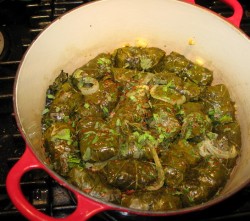
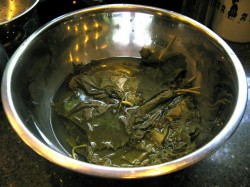
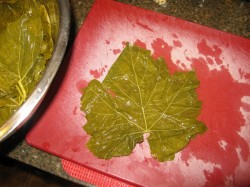
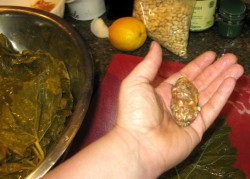
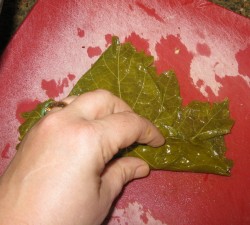
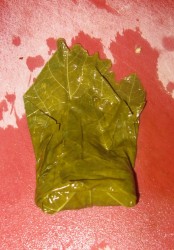
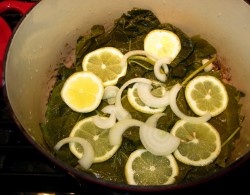
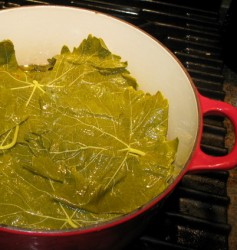



this is a gorgeous entry. i love dolmathes but i’ve never made them. usually i order them at my favorite greek restaurant and they come with thick egg-lemon sauce. i’m absolutely going to try this. thank you for the stories.
Comment by andrea — August 7, 2009 #
I love stuffed grape leaves, though being a vegetarian this is obviously not the version I’d make. I have to say, though, that at least some vegetarian stuffings do not require pre-cooking the rice – and like you, I find the whole thing much improved by letting the rice soak up flavor during the cooking process.
I like to use just lemon and salt for the water, and usually let everything simmer for 30-35 minutes after the water starts to boil. A night in the fridge does them a lot of good, but I usually don’t have that many left for the next day…
Comment by Meri — August 7, 2009 #
Mmmmmmmm….I think I need to make these this weekend. I always use par-boiled rice (almost raw, to soak up the cooking liquid) and currents in mine. And I poach them in water and lemon and olive oil.
Comment by Diane — August 7, 2009 #
Oh yum! I’m originally from Turkey where this dish is very popular, as you said. I like to make a vegetarian version which is served room temperature or cold, with perhaps only some garlic yoghurt to accompany it. The filling is made by cooking some onions in plenty of olive oil with allspice, cinnamon, dried mint, pine nuts and currants. The raw rice is then added to this mixture and sauteed for a bit til the grains get opaque. After this the leaves are stuffed with this filling, rolled and cooked pretty much as you described.
Comment by EK — August 7, 2009 #
Dolmathes are one of my favourite dishes, and it had never occurred to me to make them (not sure why!). Thank you so much for posting this!
Comment by Joanne — August 7, 2009 #
Thanks so much for this and your detailed instructions. I tried making dolmades but they unraveled. :-/
I cooked my mince first, but am going to try your method of leaving the mince & rice raw – think that’ll make it easier to roll it really tightly. Think I might’ve used too much cooking liquid as well…
I see you don’t weigh your dolmades down when they’re cooking – do the leaves tucked on top serve the same purpose?
Comment by Marisa — October 12, 2010 #
Followed your instructions and my dolmades came out intact & perfect! Thanks so much.
Comment by Marisa — October 13, 2010 #
Loved this recipe. Was my first time stuffing GL and they turned out to be both easy and great!
Comment by koe — July 9, 2011 #
Glad you liked the recipe! They are tasty, aren’t they?
Comment by Barbara — July 9, 2011 #